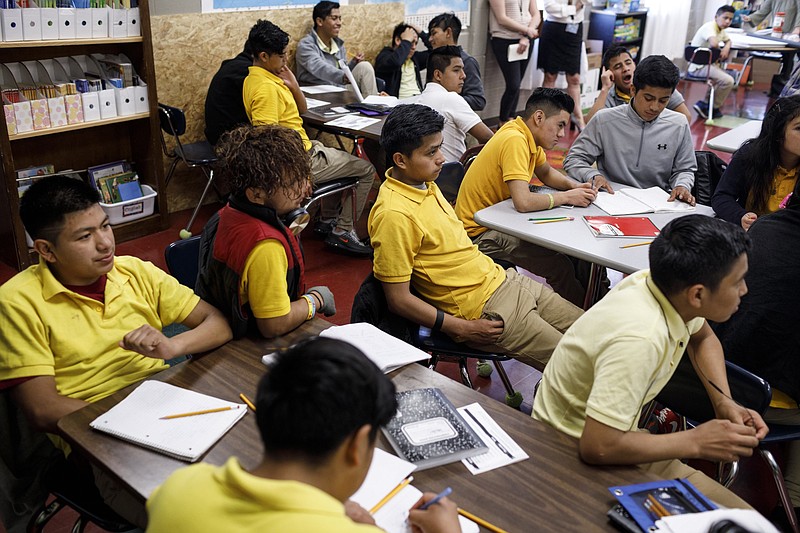Hamilton County Board of Education member Rhonda Thurman, no stranger to controversy, has created a social media firestorm by suggesting that a rising number of Hispanic students in the district are overwhelming the schools.
There are nearly 700 more Hispanic students in district schools this year than last year, bringing the total to some 8,680 students, according to data made available by the school district on Thursday. There are 4,651 students who are English language learners; of those, 3,596 are receiving services, records show.
Hispanics are now a majority of students in five county schools, including Howard School, East Lake Academy Middle School, and Clifton Hills, East Lake and East Side elementary schools, and a plurality in five others, including East Ridge High School, East Ridge Middle School, East Ridge and Spring Creek elementaries, and Chattanooga Girls Leadership Academy, a charter school.
Some teachers are frustrated because they must devote so much time to helping the Hispanic students -- many of whom speak limited or no English -- catch up to the rest of the class.
The sharing of a news report on Thurman's remarks drew more than 150 comments, almost all of them negative, on the left-leaning Nooga Holler Facebook page.
For stating that the district is overwhelmed, the longtime school board member was called a racist, a problem, culturally incompetent and a rat, among other terms.
While it's clear that Thurman and other board members cannot stem the flow of Hispanic families into the community from the country's porous Southern border, her remarks may serve as a wake-up call to the school board and perhaps to state education officials who may have taken note of her remarks.
Thurman mentioned that a new charter school aimed at immersing Hispanic students into English language learning should be a help.
The application for ChattAcademy Community School, which will offer a Spanish/English dual immersion curriculum for middle and high school students, was approved by the school board in April. It is expected to open its doors in 2023.
Of course, the district is approaching 9,000 Hispanic students, and the charter school is not likely to offer space for more than a couple of hundred students even if it becomes popular.
Undoubtedly, then, the growing number of Hispanic students who are English language learners and how they affect classrooms and schools will be an issue the school district and school board must deal with.
In the meantime, we wondered how such students fared over time -- whether they are, in fact, a burden. Would Tennessee Comprehensive Assessment Program (TCAP) test scores in the 10 schools in which Hispanic student are a plurality show growth, little change or a lack of improvement over the past six years (not including 2020, in which tests weren't administered)?
The results are mixed.
In English language arts, since 2017, Hispanics have made sizable gains at Clifton Hills, East Ridge, and, especially, Spring Creek elementary schools. But they have fallen back at East Lake Academy and East Ridge Middle School and made little progress at East Side Elementary and Chattanooga Girls Leadership Academy.
Meanwhile, their growth in the subject has exceeded that of Black students over the same period at East Lake, East Ridge, East Side and Spring Creek elementary schools, and at East Ridge Middle School.
In math, again using 2017 as a base and acknowledging the learning losses in 2021 from the pandemic, Hispanics made large gains at Clifton Hills and East Ridge elementary schools and East Ridge Middle School. But they fell back at East Lake Elementary and East Lake Academy and made a little progress at East Side and Spring Creek elementary schools and Chattanooga Girls Leadership Academy.
However, for each of the schools for which the math scores are available, Hispanic students did much better than their Black counterparts. At several of the schools, Black students even had better scores in the baseline year of 2017. Now the difference ranges from 7.3% at East Lake Elementary to 15.8% at Clifton Hills Elementary.
Enough five-year comparison scores from East Ridge High School and Howard School weren't available to gauge improvement or make comparisons between Black and Hispanic students.
This much we know. Hispanic students are here and are attending schools in Hamilton County in increasing numbers. They're not going anywhere anytime soon. It is to the public's betterment that they be educated.
We don't envy the school district and the school board in determining what resources will both help them learn and help the teachers who must teach students for whom English is not their first language.
If Thurman's comments light a fire for anyone in a position to make enlightened decisions about education in the district and state in the future, she is not off base in calling attention to the challenge the district faces in meeting the needs of all students.
It's up to all those officials as to how to make it work.
